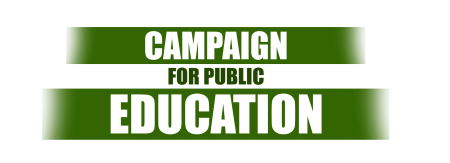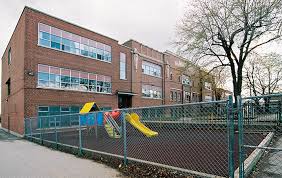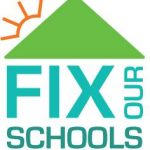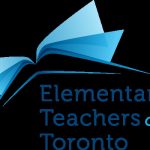The Great School Rip Off
The Great School Rip Off
Ontario has stepped up the pressure on the Toronto District School Board to close and sell more schools. In the ninth of thirteen directives handed down by the Ministry on January 15th 2015, the province flexed its majority muscle, ordering the TDSB to submit a 3 year capital plan, prepare a list of schools for the chop and get on with it. Further, the province will likely release new guidelines for Accommodation Reviews this spring. It hints at an “accelerated” process which probably means fewer public meetings and reduced parent and community participation on Accommodation Review Committees. The TDSB trustees obediently passed a motion on February 1st to prepare the way for 10 Accommodation Reviews which will likely get underway in the fall of 2015. Just reading the names of the schools on the list, it’s easy to see that once again that most of the communities targeted for losing their neighbourhood schools will be in low income areas.
The Fire Sale Thus Far:
“Since amalgamation, the TDSB has disposed of 82 properties. Of these 16 properties were disposed of by the TDSB before the formation of the Toronto Lands Corporation. The Toronto Lands Corporation has disposed of 66 properties … Approximately $470 million has been generated in revenue.” Says a document issued by the TDSB for trustee reference on January 27th 2015. It puts the selling price for a publicly owned, fully serviced school property at just under $6 million. This revenue is supposed to form the core of the Board’s capital budget. But even if the province were to match the sum dollar for dollar, it wouldn’t begin to address the Board’s $3.5 Billion maintenance deficit. To do that, they’d have to sell nearly all the schools in the system.
A total of 647.74 acres of school property has been sold to date. That puts the dollar value of school property at just below $720,000.00 per acre- the price of a three bedroom detached house in North York. How many town houses or large condo units can squeeze on an acre of land? How many will fit on the 5.8 acre site that used to be Brooks Rd. Public School in Scarborough or the 5 acre site that once was Heron Park Jr. P.S.? Both those Scarborough elementary schools were sold to private sector purchasers. Where will those new homeowners send their kids to school?
Why the low price? Because according to the TDSB’s Jan 27th document, “approximately 60% have been purchased by public sector organizations.” If the purchaser was another school board, the buyer got a 40% discount on the “fair market value” of the property. The French School Boards bought 13 of the 82 properties. Twelve went to the Toronto Catholic School Board. These twenty-five sales conveniently redistribute school properties among the province’s own jurisdictions. Win Wynne.
When a public school board wants to sell land, according to provincial regulation 4498, a rigid hierarchy of preferred buyers gets the first chance to buy it. First in line are the Catholic or French Language school boards and they get it at a discount. If the school boards don’t bite, then the municipality gets a chance. The municipality gets to pay “fair market value”- but no discount- which is still very low. Next in line come the broader public service (universities, colleges and hospitals) and then the non-profit sector. They too pay “fair market value.” Finally, if no school board, municipality, and no public sector institution or non-profit agency wants to buy the land, it goes on the open market. Then the price goes up, the bidding begins, and the land goes to the best offer. According to the Jan 27th document, 50% of the 82 properties went to the public sector, 43% went to private owners who the TDSB does not identify and 7% went to non-profit and charitable organizations. Those properties are now gone forever yet the Board didn’t really capitalize much from this liquidation of public assets.
Leasing is the Less Risky Money Generator:
The TDSB owns thirty-three properties it leases to private schools, non-profit organizations, child care centres , the Toronto Catholic District School Board and the City of Toronto according to a TDSB printout dated Jan. 27th, 2015. It shows the total net annual rental income from these properties is over $5 million. It isn’t spectacular. However, these properties will generate income year after year- not just once on the auction block. Also the properties remain in the school board’s hands ready to be reopened as operating schools, should the need for a school reappear one day.
Get Ready for More School Closings:
“Thirty buildings were closed as operating schools between 1998 and 2013. Currently, nineteen of these buildings have been sold, eight are being leased out by the Toronto Lands Corporation, and three are being used for TDSB purposes,” says the Jan 27th, 2015 document. Operating schools are the ones full of kids. According to provincial regulations in the past, if a school board chooses to close an operating school, it must conduct a Pupil Accommodation Review. Unless TDSB trustees find their backbones soon, more communities will lose their neighbourhood schools and with them, their community hubs.
In compliance with the province’s orders, the TDSB published a list of 133 schools it deemed to be below a 65% “utilization rate.” This is where the illusion of “half empty” schools comes in. Only the elementary or secondary students counted as users of the school space. Not counted were child care centres or the “Section 23” programs operated by treatment centres such as Holland Bloorview or Muki Baum. Not counted were the TDSB’s own special education “Caring and Safe Schools” for children and youth with disabilities and mental or behavioral disorders. Not counted were the 20,000 adult day school ESL students. Not counted were 78 Parenting Centres serving 14,000 preschool children and their parents and care givers. Not counted were 2,600 adult day time literacy students. Not counted were general interest and day time seniors’ programmes serving 30,000 more adults. Had they been included the utilization rate calculation, many of the “half empty” schools would have been shown to be operating at much closer to full building capacity.
The province demanded a three year plan so the Board delivered a list of 60 schools that could be closed. Most are located in the poorer communities in York, Rexdale and Scarborough. On that list there are schools which house, child care centres, treatment centre programs, special education for disable students, and adult education classes. The province seems bent on destroying the very community hubs it propounds to value. Even the mayor was alarmed.
Board Budget Blues:
All school boards have two separate budgets: the operating budget and the capital budget. The operating budget keeps the system going. The $3.1 billion operating budget covers salaries, utilities, administration, transportation- all costs related to student learning and school board operations. The $135 million capital budget pays for building new schools and for retrofitting and reconstructing existing school building facilities.
Since amalgamation in 1998, the operating budget has had annual shortfalls. From that time school boards lost their powers to raise their own revenue from local taxes. Their income now stems directly from the province. It’s never been enough. Year after year the Board pillaged one budget line to support another. It made massive cuts to staff and programs. It deferred maintenance. Huge gaps exist between provincial grants and the actual costs for just about everything: staffing allowances, salaries, libraries, guidance, ESL, special education, transportation, and school offices. This leaves the TDSB to fill the funding gaps. To compound the problem, the province rolled out expensive initiatives like all day kindergarten and a cap on class size but then didn’t provide adequate funding for them.
Meanwhile the school buildings began to crumble. Maintenance suffered as the board struggled with its operating costs and ballooned into a 3.5 maintenance deficit. Of the TDSB’s 588 operating schools, 226 are in critical condition and 55 schools are really dire and require extensive renovation. A new school costs over $25 million.
The province told school boards not to expect any increases in funding. School boards must balance their budgets and by law cannot run deficits. When school boards across the province complained bitterly about the funding formula, the province said if they couldn’t manage on the money they received, they’d have to sell some of their real estate. The proceeds from real estate sales, the province ruled, had to support their capital budgets. To sweeten the deal, the province offered matching funds for every school sold. Under tight provincial supervision, school boards could then proceed to refurbish their school buildings. But the money didn’t go very far. The sale from a $6 million dollar school plus a matching $6 million dollar grant was not sufficient to cover the massive retrofitting required. When construction costs at Nelson Mandela Park ran beyond their original estimates, the province stopped its capital grants for two years. School construction ground to a halt but property sales continued apace. The $470 million generated by TDSB property sales to date has almost dried up.
The Squeeze Is Back On:
Seventeen Years ago Mike Harris said he would close over 100 schools in Toronto. Today it’s Kathleen Wynne. The province holds all the cards. The Toronto District School Board was set up to fail from the start. The province has the board cornered. They controlled public education funding for a decade and a half and starved it.
The province’s other moves have been to undercut the political strength of elected school trustees. (It is important to recall that the former school boards in Toronto, York, East York, Etobicoke, North York and Scarborough had all managed their budgets, maintained their school buildings well and created some award winning program initiates in response to local needs before amalgamation.) The first provincial cut in 1998 was to slice trustee incomes in half. At $27,000 a year, only the retired or independently wealthy can devote the time necessary to do the job. Last week, in compliance with ministry directives, Toronto trustees voted themselves a further pay cut down to $11,000 per annum. Recently, the province removed part time constituency assistants and office space given to TDSB trustees. Both moves will ensure that the job will be done so badly, the public will not protest when the province finds an excuse to take complete control of the TDSB which judging from the Minister’s recent remarks, may happen any day. The implications for democracy in the school system are stark.
The Toronto District School Board educates fully 12% of Ontario’s children but receives only 5% of the funding available for public education in Toronto. Selling school property to augment funding is not only short sighted, it’s futile. The province must overhaul the funding formula now or restore the power of taxation to local school trustees.
Janet Bojti, Feb 20th 2015
.
Janet Bojti, Feb 20th 2015




